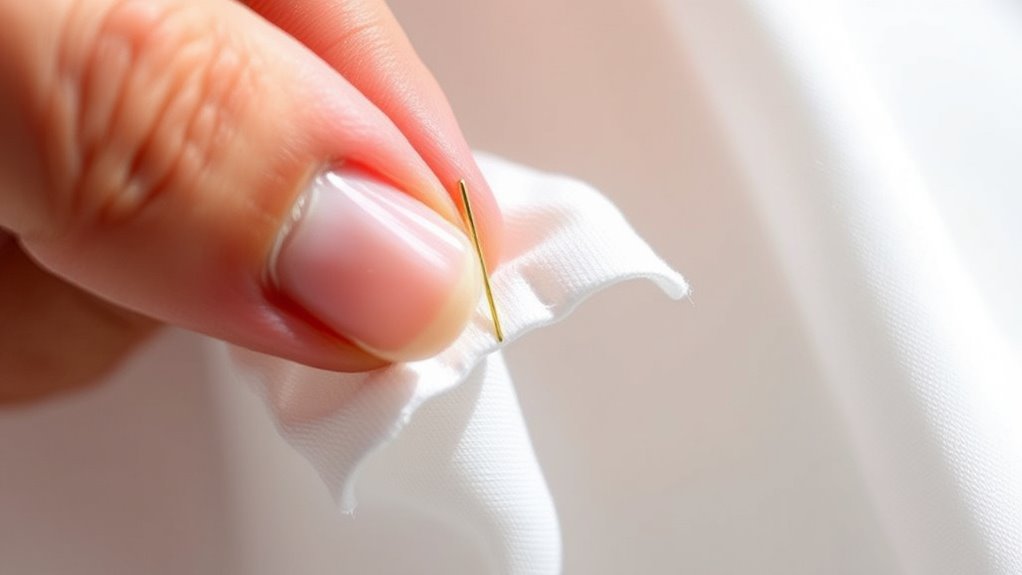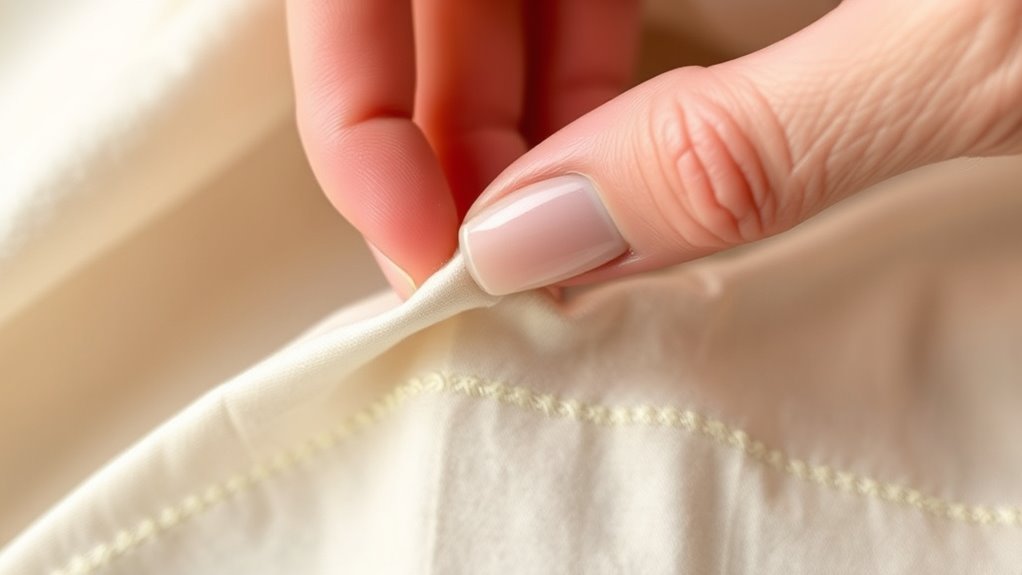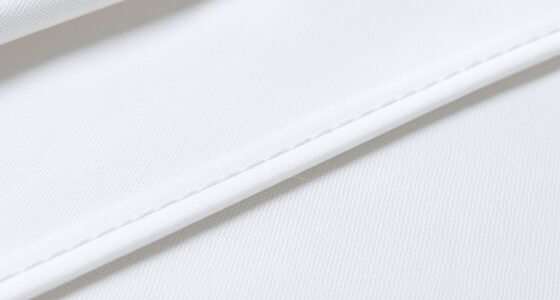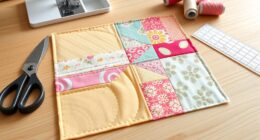Invisible Hand-Hemming with slip stitches lets you create nearly invisible finishes that subtly shape your fabric without showing stitches. You’ll work by catching just a few threads along the folded edge, pulling tight but gently, for a smooth, discreet look. This technique gives your projects a professional touch while maintaining fabric flow. Mastering it takes practice, and if you keep going, you’ll discover more tips to perfect your invisible hems seamlessly.
Key Takeaways
- Use tiny, evenly spaced stitches through the folded edge and just beneath the fabric surface to keep stitches concealed.
- Start by turning under the fabric edge or hemline to prepare for slip stitching.
- Catch only a few threads of the fabric to ensure stitches remain hidden and discreet.
- Gently pull the thread to secure the hem without puckering or distorting the fabric.
- Maintain consistent, minimal stitches for a smooth, nearly invisible finish that looks professional.

When economic shocks threaten to destabilize markets, policymakers often turn to a concept known as the “Invisible Hand-Hemming.” This approach involves using targeted interventions to subtly influence market outcomes without disrupting the natural flow of supply and demand. Similarly, in the world of hand sewing, slip stitch techniques serve as a delicate method to achieve seamless fabric finishing, allowing garments to look polished without visible stitches. Mastering these stitches ensures that your work remains discreet, maintaining the integrity of the fabric while providing a clean, professional finish.
The slip stitch is a versatile hand sewing technique that plays a vital role in fabric finishing. It’s perfect for hemming garments, closing seams, or attaching linings invisibly. When you use a slip stitch, you essentially thread your needle through the fabric’s fold or edge, catching only a few threads in a way that conceals your stitches from view. This subtle approach aligns with the concept of influence without overt intervention—your stitches adjust the fabric’s appearance without drawing attention to themselves. It’s a precise method that requires patience but offers a seamless look, especially valuable in delicate or lightweight fabrics.
To execute a slip stitch effectively, you start by turning your fabric edge or fold under. Then, you take tiny stitches through the folded edge and just beneath the fabric’s surface, catching only a few threads. Pull gently to secure the stitch without puckering the fabric. As you continue, keep your stitches evenly spaced and barely visible on the outside, ensuring a smooth finish. This technique is particularly useful for fabric finishing because it allows you to conceal your stitches, making the hem or seam almost invisible, which enhances the overall appearance of your sewing project.
Practicing slip stitches will give you more control over fabric finishing, especially when working with fine or delicate textiles. The skill lies in making your stitches small and consistent, so they blend into the fabric seamlessly. It’s a subtle form of influence—akin to the “Invisible Hand-Hemming”—where your sewing guides the fabric into a perfect, invisible finish, without disrupting the garment’s flow or structure. Over time, this technique becomes second nature, allowing you to produce professional-looking hems and seams that stand out for their invisibility and precision.
In essence, mastering slip stitch techniques elevates your hand sewing, giving you the ability to finish fabrics with finesse. Whether you’re hemming a dress or securing a lining, this method offers a way to influence the final appearance subtly and effectively, much like the market strategies that rely on unobtrusive yet impactful interventions.
Frequently Asked Questions
Can Invisible Hand‑Hemming Be Used on Stretchy Fabrics?
You might wonder if invisible hand‑hemming can be used on stretchy fabrics. Generally, it’s not ideal because stretchy fabric hemming requires techniques that accommodate fabric elasticity considerations. Using invisible hand‑hemming on stretchy textiles can restrict movement or cause puckering. For best results, opt for stretch stitches or a zigzag stitch to preserve the fabric’s flexibility and ensure a smooth, professional finish.
What Tools Are Essential for Invisible Hand‑Hemming?
Ever wondered what tools make invisible hand-hemming smooth? You’ll need a fine sewing needle to sew discreetly without puckers. Hemming tape is also essential for securing the hem temporarily or permanently, especially on delicate fabrics. These tools help you achieve a clean, professional finish. With just a sewing needle and hemming tape, you can effortlessly create an invisible hem that looks flawless and lasts—ready to impress everyone!
How Do I Correct Mistakes in Invisible Hand‑Hemming?
When you make a mistake in invisible hand-hemming, you can fix it by carefully undoing the stitch for stitch repair. Use a fine needle to gently remove the stitches without damaging the fabric, then re-hem for a clean hem adjustment. It’s best to work slowly and patiently, ensuring your repair blends seamlessly. This method keeps your hem neat and professional-looking, even if you need to correct an earlier stitch.
Is Invisible Hand‑Hemming Suitable for All Garment Types?
Imagine you’re sewing a delicate silk blouse; you might wonder if invisible hand‑hemming suits all garments. While it’s great for invisible finishes and some decorative applications, it’s not ideal for heavy or textured fabrics, which can be difficult to stitch smoothly. Fabric compatibility is key. For thick denim or bulky wool, traditional methods work better. So, consider your fabric type and the garment’s purpose before choosing invisible hand‑hemming.
How Long Does an Invisible Hand‑Hem Typically Last?
You wonder how long an invisible hand-hem typically lasts. Its durability depends on factors like fabric compatibility and how well you execute the slip stitch. Generally, if you use sturdy thread and match the fabric, the hem can last through multiple washes and wears. However, delicate fabrics or improper technique may reduce its lifespan. Proper care and suitable materials are key to ensuring your invisible hand-hem remains durable over time.
Conclusion
Now that you’ve mastered invisible hand-hemming, imagine the perfect finish waiting just beneath the surface. With each slip stitch, you’re quietly sealing your project’s fate, unseen but essential. Will this subtle technique become your secret weapon for flawless hems? As you pull the thread tight, a sense of satisfaction builds—yet the true magic lies in the unexpected durability it offers. Are you ready to see where this skill can take your sewing to new heights?









